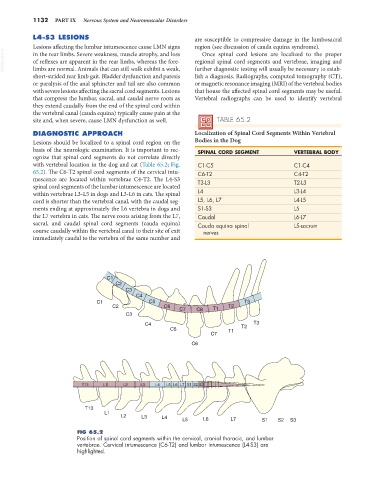Page 1160 - Small Animal Internal Medicine, 6th Edition
P. 1160
1132 PART IX Nervous System and Neuromuscular Disorders
L4-S3 LESIONS are susceptible to compressive damage in the lumbosacral
Lesions affecting the lumbar intumescence cause LMN signs region (see discussion of cauda equina syndrome).
VetBooks.ir in the rear limbs. Severe weakness, muscle atrophy, and loss regional spinal cord segments and vertebrae, imaging and
Once spinal cord lesions are localized to the proper
of reflexes are apparent in the rear limbs, whereas the fore-
limbs are normal. Animals that can still walk exhibit a weak,
lish a diagnosis. Radiographs, computed tomography (CT),
short-strided rear limb gait. Bladder dysfunction and paresis further diagnostic testing will usually be necessary to estab-
or paralysis of the anal sphincter and tail are also common or magnetic resonance imaging (MRI) of the vertebral bodies
with severe lesions affecting the sacral cord segments. Lesions that house the affected spinal cord segments may be useful.
that compress the lumbar, sacral, and caudal nerve roots as Vertebral radiographs can be used to identify vertebral
they extend caudally from the end of the spinal cord within
the vertebral canal (cauda equina) typically cause pain at the
site and, when severe, cause LMN dysfunction as well. TABLE 65.2
DIAGNOSTIC APPROACH Localization of Spinal Cord Segments Within Vertebral
Lesions should be localized to a spinal cord region on the Bodies in the Dog
basis of the neurologic examination. It is important to rec- SPINAL CORD SEGMENT VERTEBRAL BODY
ognize that spinal cord segments do not correlate directly
with vertebral location in the dog and cat (Table 65.2; Fig. C1-C5 C1-C4
65.2). The C6-T2 spinal cord segments of the cervical intu- C6-T2 C4-T2
mescence are located within vertebrae C4-T2. The L4-S3 T3-L3 T2-L3
spinal cord segments of the lumbar intumescence are located
within vertebrae L3-L5 in dogs and L3-L6 in cats. The spinal L4 L3-L4
cord is shorter than the vertebral canal, with the caudal seg- L5, L6, L7 L4-L5
ments ending at approximately the L6 vertebra in dogs and S1-S3 L5
the L7 vertebra in cats. The nerve roots arising from the L7, Caudal L6-L7
sacral, and caudal spinal cord segments (cauda equina) Cauda equina spinal L5-sacrum
course caudally within the vertebral canal to their site of exit nerves
immediately caudal to the vertebra of the same number and
C1
C2
C3
C4
C1 C5 T3
C2 C6 T2
C7 C8 T1
C3
C4 T2 T3
C5 T1
C7
C6
T13 L1 L2 L3 L4 L5 L6 L7 S1 S2 S3
T13
L1
L2 L3 L4 L5 L6 L7 S1 S2 S3
FIG 65.2
Position of spinal cord segments within the cervical, cranial thoracic, and lumbar
vertebrae. Cervical intumescence (C6-T2) and lumbar intumescence (L4-S3) are
highlighted.

